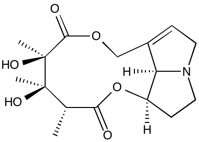Monocrotaline | Induces pulmonary fibrosis
NMR (Conforms)

Available Options
| Size : | Price | Quantity | |
|---|---|---|---|
| 50 mg | $58.00 | ||
| 250 mg | $120.00 |
Monocrotaline (315-22-0) is a naturally occurring pyrrolizidine alkaloid used to create an animal model of pulmonary arterial hypertension (PAH). It can mimic several important aspects of human PAH including vascular remodeling, proliferation of smooth muscle cells, endothelial dysfunction, production of inflammatory cytokines and right ventricle failure.1 Induces endoplasmic reticulum stress in a rat model of PAH.2 Induces sinusoidal obstruction syndrome, a form of drug-induced liver injury.3 May be used to establish a mouse model of pulmonary fibrosis.4
References/Citations:
1) Nogueira-Ferreira et al. (2015), Exploring the monocrotaline animal model for the study of pulmonary arterial hypertension: A network approach; J. Pulm. Pharmacol. Ther., 35 8
2) Wang et al. (2016), Evaluation and Treatment of Endoplasmic Reticulum (ER) Stress in Right Ventricular Dysfunction during Monocrotaline-Induced Rat Pulmonary Arterial Hypertension; Cardiovasc. Drugs Ther., 30 587
3) Nakamura et al. (2012), Sorafenib attenuates monocrotaline-induced sinusoidal obstruction syndrome in rats through suppression of JNK and MMP-9; J. Hepatol., 57 1037
4) Hayashi et al. (1995) Establishment of an animal model for pulmonary fibrosis in mice using monocrotaline; Toxicol. Pathol. 23 63
NMR (Conforms)
Safety Data Sheet:
Product Data Sheet:
Materials provided by Focus Biomolecules are for laboratory research use only and are not intended for human or veterinary applications. Please note that we do not sell to individuals and that all orders placed by non-research organizations will incur a $20 restocking/refund fee
Monocrotaline (315-22-0) is a naturally occurring pyrrolizidine alkaloid used to create an animal model of pulmonary arterial hypertension (PAH). It can mimic several important aspects of human PAH including vascular remodeling, proliferation of smooth muscle cells, endothelial dysfunction, production of inflammatory cytokines and right ventricle failure.1 Induces endoplasmic reticulum stress in a rat model of PAH.2 Induces sinusoidal obstruction syndrome, a form of drug-induced liver injury.3 May be used to establish a mouse model of pulmonary fibrosis.4
References/Citations:
1) Nogueira-Ferreira et al. (2015), Exploring the monocrotaline animal model for the study of pulmonary arterial hypertension: A network approach; J. Pulm. Pharmacol. Ther., 35 8
2) Wang et al. (2016), Evaluation and Treatment of Endoplasmic Reticulum (ER) Stress in Right Ventricular Dysfunction during Monocrotaline-Induced Rat Pulmonary Arterial Hypertension; Cardiovasc. Drugs Ther., 30 587
3) Nakamura et al. (2012), Sorafenib attenuates monocrotaline-induced sinusoidal obstruction syndrome in rats through suppression of JNK and MMP-9; J. Hepatol., 57 1037
4) Hayashi et al. (1995) Establishment of an animal model for pulmonary fibrosis in mice using monocrotaline; Toxicol. Pathol. 23 63
Calculate the molar concentration, mass or volume in a solution.
Concentration × Volume × Molecular Weight = Mass
Focus Biomolecules • Plymouth Meeting, PA USA • 1-855-FOCUS21
Focus Biomolecules
Plymouth Meeting, PA USA
1-855-FOCUS21
Website Created by Advanta Advertising LLC.

